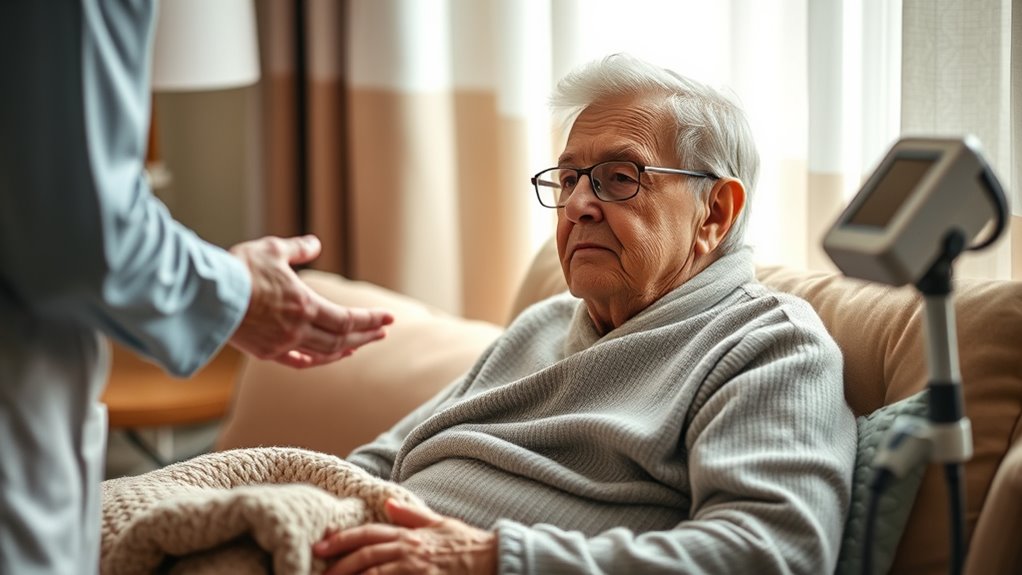Palliative care helps you manage pain and rigidity in Parkinson’s by optimizing your medications, adjusting doses, and introducing therapies tailored to your needs. Emotional support is essential—it helps you cope with frustrations and feelings of helplessness, making life more manageable. Practical guidance for caregivers, like exercises and body positioning, also improves daily comfort. Combining these approaches offers relief and dignity—continue exploring to discover how a holistic plan can make a meaningful difference for you.
Key Takeaways
- Palliative care optimizes medication management to control pain and reduce rigidity effectively.
- Emotional support helps patients cope with physical discomfort and enhances overall well-being.
- Education on gentle exercises and proper positioning can alleviate symptoms and improve daily comfort.
- A holistic approach combines physical, emotional, and practical strategies for comprehensive symptom relief.
- Palliative care fosters dignity and control, improving quality of life despite Parkinson’s progression.

Have you wondered how palliative care can improve quality of life for someone with Parkinson’s? One of the main ways it does this is by helping manage pain and rigidity, which are common and often debilitating symptoms. Palliative care teams focus on personalized strategies, ensuring that medication management is optimized to reduce discomfort. They work closely with neurologists and other specialists to adjust medications, timing doses precisely, and introduce new therapies when needed. This careful management aims to control muscle stiffness and reduce pain episodes, allowing for greater mobility and comfort. You’ll find that regular assessments help identify the most effective medication plans, minimizing side effects and avoiding unnecessary fluctuations in symptoms. Incorporating comprehensive symptom management is essential for improving daily functioning and overall well-being. But managing physical symptoms is only part of the equation. Emotional support plays a essential role in addressing pain and rigidity, especially since these symptoms can lead to frustration, anxiety, and depression. Palliative care providers recognize that emotional well-being directly influences physical health. They create a safe space for your loved one to express fears and frustrations, helping them cope with the challenges of Parkinson’s. Through counseling, support groups, or simply empathetic listening, emotional support can alleviate feelings of isolation and helplessness. When someone feels understood and supported, their overall pain levels may decrease, and they can engage more actively in their treatment plan.
The team also educates both patients and their caregivers about managing symptoms at home. This includes guidance on gentle exercises, proper body positioning, and relaxation techniques that can reduce rigidity and ease discomfort. Such interventions empower caregivers to assist effectively, ensuring the person with Parkinson’s feels more in control. Palliative care also emphasizes the importance of consistency in medication routines, which helps prevent sudden increases in rigidity or pain.
Ultimately, addressing pain and rigidity through palliative care involves a holistic approach. It’s not just about prescribing medication but about providing ongoing emotional support and practical strategies that improve daily life. When you combine medication management with compassionate emotional care, you help your loved one experience less suffering and more moments of comfort. This comprehensive approach recognizes the physical and emotional toll of Parkinson’s, fostering a better quality of life despite the progression of the disease. Palliative care isn’t a cure, but it’s a critical resource in managing symptoms and offering dignity and relief when it’s needed most.
Frequently Asked Questions
How Early Should Palliative Care Be Considered in Parkinson’s Progression?
You should consider early intervention with palliative care soon after your Parkinson’s diagnosis, ideally when symptoms begin impacting your quality of life. Engaging in patient education early helps you understand your condition and manage symptoms effectively. Starting palliative care early ensures you receive thorough support for pain and rigidity, allowing you to maintain independence and comfort throughout your disease progression.
Can Palliative Care Improve Cognitive Symptoms in Parkinson’s Patients?
While palliative care primarily eases physical symptoms, it can also enhance cognitive well-being by providing emotional support and advanced planning. You might picture a clearer mind amid the chaos, as tailored strategies reduce anxiety and confusion. Palliative care fosters a supportive environment, helping you manage cognitive challenges better. This holistic approach addresses emotional needs, empowering you to face Parkinson’s with dignity and improved mental clarity.
What Are the Potential Side Effects of Pain Management Medications?
Pain management medications can cause side effects like drowsiness, nausea, and constipation. You should watch for medication interactions that might worsen side effects or reduce effectiveness. To manage these side effects, communicate with your healthcare provider regularly, adjust dosages if needed, and follow recommended guidelines. Proper side effect management helps you stay comfortable and guarantees your medications work effectively, improving your quality of life.
How Does Palliative Care Coordinate With Other Parkinson’s Treatments?
Palliative care coordinates with your Parkinson’s treatments by integrating holistic approaches that address physical, emotional, and psychological needs. It works alongside medications and therapies to optimize your quality of life. Family involvement is vital, as it helps create a supportive environment, guaranteeing your care plan is tailored to your evolving needs. This teamwork ensures you receive extensive support, easing symptoms and enhancing comfort throughout your Parkinson’s journey.
Are There Specific Therapies for Managing Rigidity Besides Medication?
You might think medications are the only answer, but guess what? Physical therapy and massage therapy are surprisingly effective for managing rigidity. They help loosen muscles, improve flexibility, and reduce stiffness—no prescriptions needed. It’s almost ironic how these hands-on approaches can sometimes outperform drugs, giving you more control. So, don’t overlook these therapies; they might just be your secret weapons against rigidity.
Conclusion
By embracing palliative care, you can markedly ease the pain and rigidity that Parkinson’s brings. Imagine caring for a loved one who, thanks to specialized support, can enjoy moments of comfort and dignity despite their symptoms. You have the power to make a difference, helping them live more fully. Don’t wait—consider palliative care today to provide relief, comfort, and a better quality of life for those you cherish.






